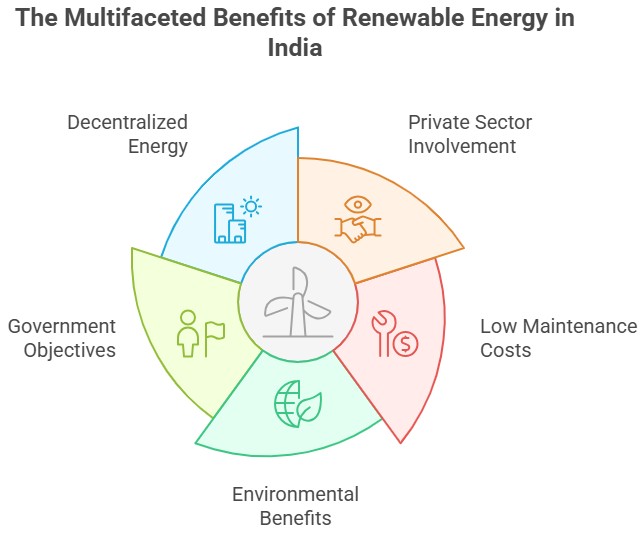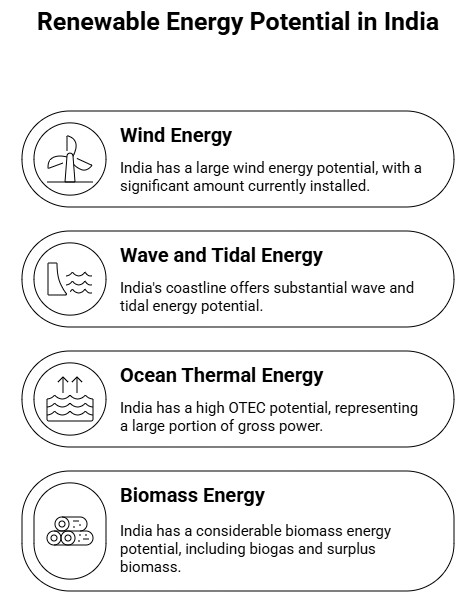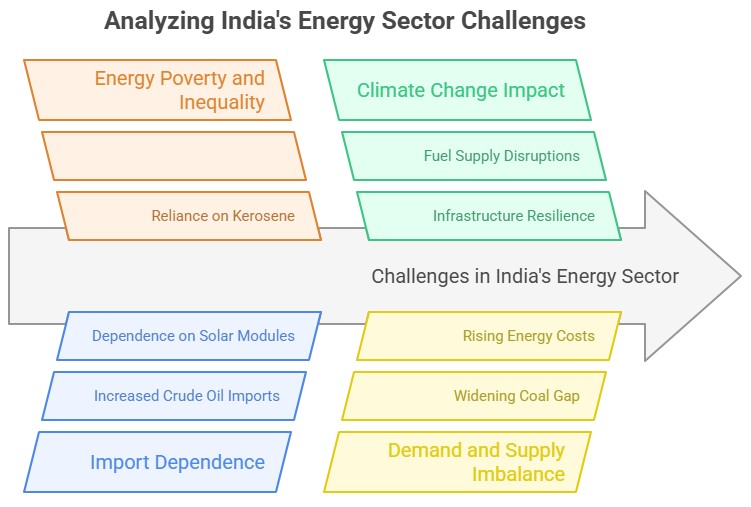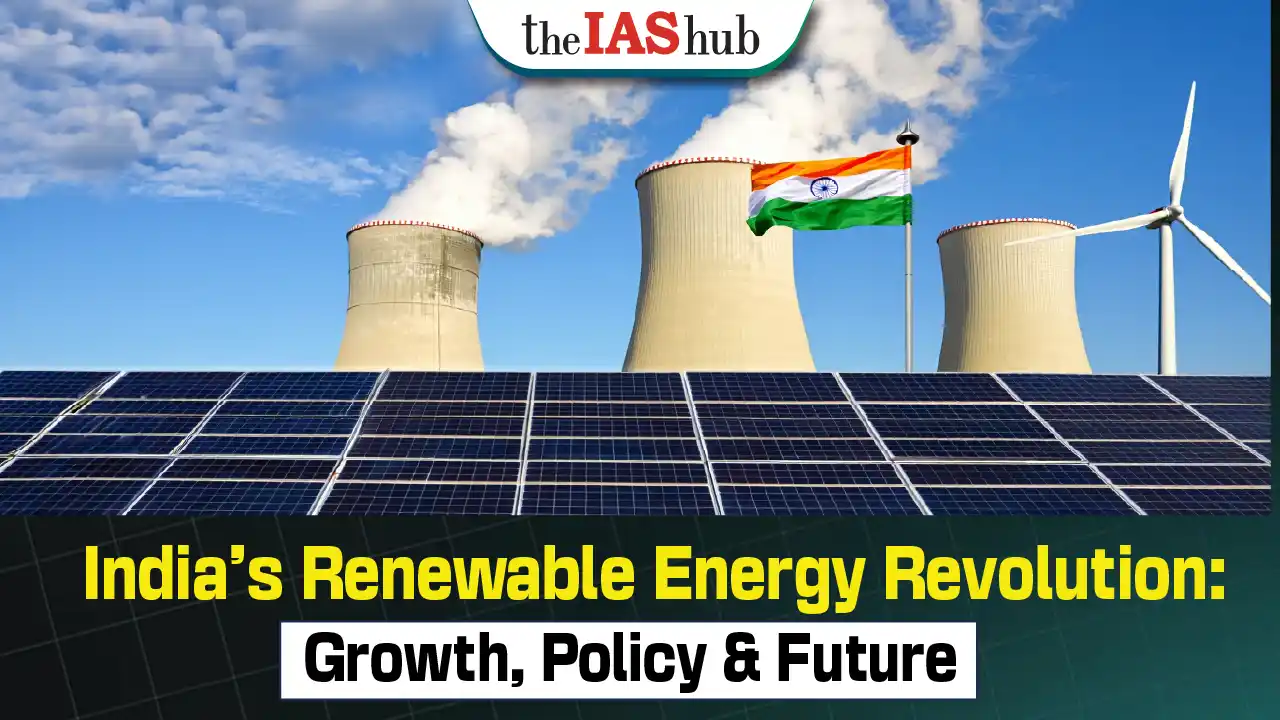Power plays a pivotal role in the economic prosperity and welfare of nations. A robust and sustainable power sector is indispensable for fostering India's economic growth.
As per the recent report "Investing for Impact: Renewable Energy & Cleantech" by Aspire Circle, an investment of $350 billion in renewable energy and cleantech ventures can potentially enable India to generate a staggering $212 billion in revenue, create 3.4 million jobs, and positively impact the lives of 919 million individuals by 2030.
Renewable Energy in India
Renewable energy encompasses energy derived from natural resources that replenish themselves over time.
- It comprises various sources, such as solar energy, wind energy, hydroelectric power, wave energy, ocean thermal energy conversion, tidal energy, and biomass power.


The Role of REN21 in Promoting Renewable Energy
- The Renewable Energy Policy Network for the 21st Century (REN21) assumes a crucial role in accelerating the global transition to renewable energy.
- It facilitates the formulation of effective policies, fosters knowledge exchange, and promotes collaborative action among governments, NGOs, research institutions, international organizations, and businesses.
- REN21 acts as a catalyst to expedite the widespread adoption of renewable energy.
- According to REN21, renewable energy generation witnessed a substantial growth of nearly 7% in the past year, thereby accounting for 29% of the global electricity generation mix, up from 27% in 2019.
India's Renewable Energy Focus for the Next 5 Years
Methanol and Biomass
- Emphasis on utilizing alternative options like methanol-based economies and biomass. Government's target of bio-CNG vehicles with a 20% gasoline blend.
- Biomass energy generation as a cleaner option to reduce reliance on fossil fuels. Biomass-based fuels offer high calorific value and are cleaner compared to traditional biomass.
The Dual Challenge
- India faces the challenge of providing more and cleaner energy to its population. Focus on manufacturing solar panels under the Atma Nirbhar Bharat initiative.
- Developing the entire supply chain for components other than the manufacturing sector.
Hydrogen-based Fuel Cell Vehicles (FCV)
- Transitioning to Hydrogen-Based Fuel Cell Vehicles as a key area of focus.
- Expected to transform the renewables landscape.
Grid Integration: Importance of creating efficient methods to supply variable renewable energy to the grid.
Benefits of Renewable Energy in India
- Private sector involvement: Government's target of 450GW from renewables opens opportunities for private sector involvement in design and manufacturing, boosting profits.
- Low cost of maintenance: Renewable energies like wind energy, biopower or solar energy requires almost zero maintenance and thus provide longer working hours and reduced labor cost.
- Environment friendly: as they have almost nil carbon footprint and does not emit any harmful pollutants like PM2.5 or PM10 or greenhouse gases like carbon dioxide, NOx etc.
- Fulfill several government objectives: like achieving the Panchamrit goals, SDGs, Make in India, INDC of Paris Climate Deal and employment generation.
- Decentralized: Renewable energy plants can be located near the location of demand for energy
- For example, UT Daman has been receiving its energy completely from solar energy generated inside and in the vicinity of the city, thus reducing its dependence on the national power grid.

Factors Increasing Renewable Energy Demand in India
- Waiver of Inter-state Transmission Charges: The sale of solar and wind power is exempted from inter-state transmission charges, boosting demand.
- Renewable Purchase Obligation (RPO) Targets: State DISCOMS are obligated to meet renewable purchase targets, stimulating demand for renewable energy.
- Foreign Direct Investment (FDI): Permitting FDI in the renewable sector has accelerated progress and attracted investment.
- Rebound in Economy: The rising demand for electricity following the COVID-19 lockdowns has contributed to increased demand for renewable energy.
- Falling Prices of Renewable Energy: The cost of renewable energy has significantly decreased, with solar energy tariffs reduced by up to 80% since 2008.
- Government Support for Manufacturing Solar Photovoltaic Modules: Schemes, such as Production Linked Incentive schemes, aim to boost competitiveness and attract investment in manufacturing solar modules.
Need for Transition to Renewable Energy
- Addressing the Climate Crisis: The continuous burning of fossil fuels for power generation contributes to climate disruption. Transitioning to renewable energy can limit climate change and enhance energy security.
- Volatile Supplies of Non-renewable Energy: Regional conflicts and international sanctions on major energy producers like Iran and Russia have led to unstable supplies of non-renewable energy sources.
- Promoting Sustainable Development: Shifting to renewable energy reduces pollution externalities and promotes a green economy, aligning with sustainable development goals.
- Commitments to International Agreements: As a signatory to the Paris Climate Agreement, India is committed to increasing its renewable energy capacity to 450 GW by 2030.
- Government Targets: The Indian government has set targets to reduce carbon emissions, decrease carbon intensity, achieve net-zero emissions by 2070, and expand renewable energy capacity to 450 GW by 2030.
Renewable Energy Prospects in India
- Attractiveness for Renewable Energy Investment: EY's Renewable Energy Country Attractiveness Index ranks India as the third most attractive destination, behind the USA and China.
- Wind Energy Potential: India has an estimated wind energy potential of 102,788 MW at a height of 80m. The current installed capacity is 22,645 MW.
- Wave and Tidal Energy Potential: India's coastline of 7,500 km holds an estimated wave energy potential of about 40,000 MW. Additionally, there is a potential of 8,000 MW of tidal energy.
- Ocean Thermal Energy Conversion (OTEC) Potential: India's OTEC potential is estimated at 180,000 MW, accounting for 40% of gross power considering parasitic losses.
- Biomass Energy Potential: India possesses a significant biomass energy potential of 19,500 MW, including biogas-based cogeneration and surplus biomass. Currently, 537 MW is commissioned, and 536 MW is under construction.
- Private Sector Interest: Major Indian private companies, such as Reliance Power, are showing interest in the renewable energy sector, with plans to invest Rs 5 lakh crore in green energy projects.

India's Achievements in the Renewable Energy Sector
- Investment Attraction: Over the past six years, India has attracted a staggering investment of more than Rs 4.7 lakh crore in the renewable energy sector.
- Impressive Growth: India has witnessed a remarkable 20% compound annual growth rate (CAGR) in renewable energy generation since FY16. In comparison, the overall electricity generation in the country grew at a rate of 4.3% during the same period.
- Reduced Cost: The cost of energy from large-scale solar projects, known as Levelized Cost of Energy (LCOE), has dropped significantly in India.
- Global Position: India currently holds the fourth position worldwide in terms of overall installed renewable energy capacity. Renewable energy contributes 26.53% to the country's total installed generation capacity.
- Capacity Expansion: Over the last 7.5 years, India has experienced an impressive 286% increase in renewable energy installed capacity.
- World's Largest Renewable Energy Park: Gujarat is home to the installation of the world's largest solar-wind hybrid project, with a capacity of 30 GW.
Challenges of Renewable Energy in India
- High Initial Installation Cost: Compared to coal-based power plants, wind-based plants require higher initial investments, making the cost per MW approximately Rs 6 crore, given a capacity utilization of 25%.
- Reliability Concerns: Solar and wind energy, due to their variable nature, require support from conventional power sources to ensure consistent availability.
- Storage Infrastructure: Investing in affordable, high-capacity batteries is crucial to overcome the intermittency of renewable energy sources.
- Funding Constraints: The need for large-scale projects to achieve economies of scale presents a deterrent for private companies to initially invest in the renewable energy sector.
- Limited Social Acceptance: Despite government subsidies for solar water heaters and lighting systems, urban India has yet to fully embrace renewable-based energy systems.
- Weak Domestic Manufacturing Capability: Enhancing manufacturing capacity within India is crucial to reduce reliance on imports and promote self-sufficiency, resulting in job creation.
- Sustainability: Balancing reliable energy access, affordability for consumers, and financial stability for DISCOMs is a vital aspect of India's transition towards renewable energy.
India's Facilitation of the Green Energy Transition
India, as the world's third-largest energy-consuming country, is taking significant steps towards a green energy transition. While the majority of energy demand is still met by coal, oil, and solid biomass, India is actively pursuing renewable energy alternatives. Key initiatives include:
- Ambitious Capacity Expansion: India has set a target to reach 450 GW of installed renewable energy capacity by 2030.
- Production Linked Incentive Scheme (PLI): The government's PLI scheme aims to boost the manufacturing sector by encouraging the production of raw materials for renewable energy.
- PM-KUSUM: The Pradhan Mantri-Kisan Urja Suraksha evam Utthaan Mahabhiyan focuses on providing financial and water security to farmers by harnessing 30,800 MW of solar energy capacity by 2022. This initiative includes the solarization of water pumps for distributed power supply.
- Akshay Urja Portal and India Renewable Idea Exchange (IRIX) Portal: The Ministry of New and Renewable Energy hosts these online platforms, promoting the exchange of ideas and fostering collaboration among energy-conscious Indians and the global community.
Challenges Related to India’s Energy Sector
- Energy Poverty and Inequality
- Approximately 77 million households still rely on kerosene for lighting.
- Rural areas are particularly affected, with up to 44% of households lacking electricity access.
- Import Dependence and Weaponization of Supply Chain
- India's crude oil import bill increased by 76% to USD 90.3 billion in the first half of 2022-23, accompanied by a 15% rise in total import quantity.
- India's reliance on foreign countries like China for solar modules exacerbates the issue, as there is no backward integration in the solar value chain.
- Climate Change Induced Energy Crisis
- Climate change has a direct impact on fuel supply, energy requirements, and the resilience of existing and future energy infrastructure.
- Women’s Health at Risk
- The use of non-clean energy sources increases the risk of respiratory, cardiovascular, and psychological diseases for women, as well as maternal and infant mortality.
- Widening Gap Between Demand and Supply of Coal
- Data from the Ministry of Coal in 2021 show a growing disparity between the demand and domestic supply of coal.
- Increasing Demand, Increasing Energy Cost
- Urbanization and industrialization lead to an increasing demand for energy in India, projected to rise by more than 3% annually.

Government Policies for the Promotion of Renewable Energy in India
- Renewable Energy Certificate (REC) Mechanism
- The REC mechanism is a market-based instrument that promotes renewable energy and facilitates compliance with renewable purchase obligations (RPO).
- It aims to address the mismatch between renewable energy availability and RPO requirements.
- Green Hydrogen Mission
- The mission focuses on meeting climate targets and establishing India as a green hydrogen hub.
- The goal is to produce 5 million tonnes of green hydrogen by 2030, along with the development of renewable energy capacity.
- Production Linked Incentive (PLI) Scheme
- The PLI scheme aims to promote renewable energy storage infrastructure and manufacturing capacity through the National Programme on Advanced Chemistry Cell (ACC) Battery Storage.
- Green Term Ahead Market (GTAM)
- The pan-India GTAM is an alternative model introduced to sell renewable power in the open market without long-term power purchase agreements (PPAs).
- It contributes to greening the short-term power market.
International Efforts
- The India Energy Modeling Forum was launched under the US-India Energy partnership.
- The International Solar Alliance, a treaty-based inter-governmental organization, mobilizes investment for solar energy deployment.
- Solar Energy Corporation of India (SECI)
- SECI facilitates the implementation of the National Solar Mission and the development of renewable energy technologies throughout India.
- National Offshore Wind Energy Policy, 2015
- The Ministry of New & Renewable Energy (MNRE) explores and promotes offshore wind farms in the Exclusive Economic Zone (EEZ).
Way Forward
- Interlinking Women Empowerment with Green Energy
- Promoting women's empowerment and leadership in the energy sector can accelerate the transition to a low-carbon economy.
- Gender equality should be integrated into the "just transition" to ensure equal opportunities in green jobs.
- Women can contribute to the green energy transition through entrepreneurship and policy-making.
- Diversifying Green Supply Chain
- Clean energy supply chains should be diversified across a larger number of countries beyond developed nations.
- Climate finance under COP27 can aid in managing the shift of revenues and employment from traditional energy sources to renewable energy.
- Incentivizing Least-Cost Energy Solutions
- Encouraging university-level innovations can drive economically viable clean energy transition.
- India's demographic dividend can be utilized by promoting research and innovation in clean energy.
- Programs like UJALA and campaigns promoting sustainable lifestyles contribute to this objective.
- Focusing on Green Transport
- Restoring confidence in public transport, adopting e-buses, and developing electric freight corridors are crucial.
- Tightening emission norms and promoting biofuels can replace fossil fuels in the transportation sector.
- Multisectoral Approach to Energy Transition
- India should focus on energy system design, urban development, industrial growth, and supply-chain management to achieve future resilience.
- Gradual reduction of commodity imports and promotion of domestic manufacturing can enhance self-sufficiency.
- Leveraging Make in India can transform India into a self-sufficient and globally competitive green energy export hub.
Conclusion
Renewable energy is the future and holds the potential to eliminate fossil fuel-based energy by 2050, leading to improved environmental health. A clear policy guideline is crucial to efficiently integrate energy sources into the grid and achieve maximum efficiency.
















